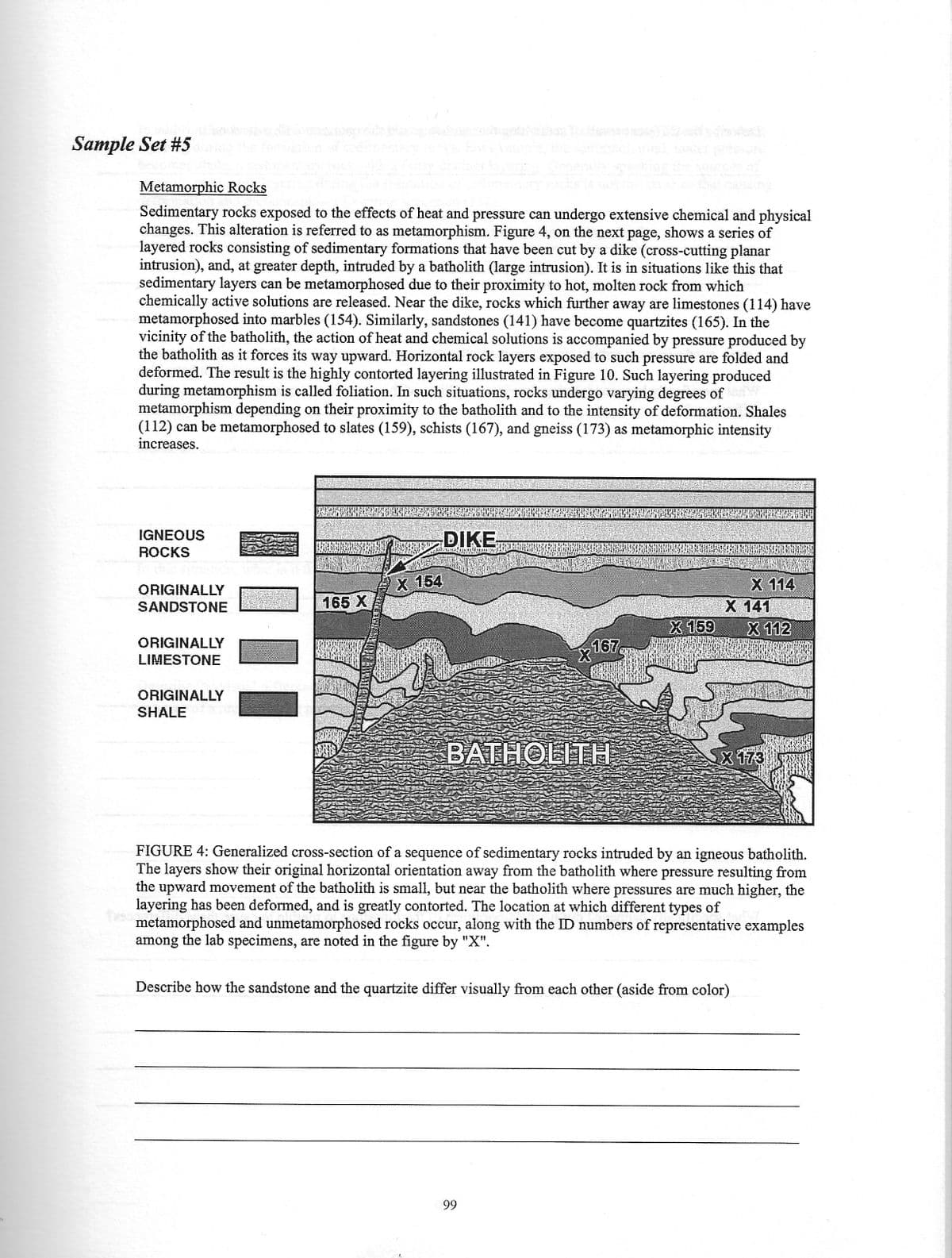Describe the different result of scratching the sandstone and the quartzite with a steel nail. Sample Set 84 What specifically happened during the metamorphism of the sandstone to quartzite to causes these differences? Describe the visual differences between the limestone and the marble. What specifically happened during metamorphism of the limestone to marble to cause these differences? 100
Describe the different result of scratching the sandstone and the quartzite with a steel nail. Sample Set 84 What specifically happened during the metamorphism of the sandstone to quartzite to causes these differences? Describe the visual differences between the limestone and the marble. What specifically happened during metamorphism of the limestone to marble to cause these differences? 100
Applications and Investigations in Earth Science (9th Edition)
9th Edition
ISBN:9780134746241
Author:Edward J. Tarbuck, Frederick K. Lutgens, Dennis G. Tasa
Publisher:Edward J. Tarbuck, Frederick K. Lutgens, Dennis G. Tasa
Chapter1: The Study Of Minerals
Section: Chapter Questions
Problem 1LR
Related questions
Question
Please type your answers and respond to each question.

Transcribed Image Text:Describe the different result of scratching the sandstone and the quartzite with a steel nail.
What specifically happened during the metamorphism of the sandstone to quartzite to causes these
of differences?
Describe the visual differences between the limestone and the marble.
What specifically happened during metamorphism of the limestone to marble to cause these differences?
100

Transcribed Image Text:B
Sample Set #5
Metamorphic Rocks
Sedimentary rocks exposed to the effects of heat and pressure can undergo extensive chemical and physical
changes. This alteration is referred to as metamorphism. Figure 4, on the next page, shows a series of
layered rocks consisting of sedimentary formations that have been cut by a dike (cross-cutting planar
intrusion), and, at greater depth, intruded by a batholith (large intrusion). It is in situations like this that
sedimentary layers can be metamorphosed due to their proximity to hot, molten rock from which
chemically active solutions are released. Near the dike, rocks which further away are limestones (114) have
metamorphosed into marbles (154). Similarly, sandstones (141) have become quartzites (165). In the
vicinity of the batholith, the action of heat and chemical solutions is accompanied by pressure produced by
the batholith as it forces its way upward. Horizontal rock layers exposed to such pressure are folded and
deformed. The result is the highly contorted layering illustrated in Figure 10. Such layering produced
during metamorphism is called foliation. In such situations, rocks undergo varying degrees of
metamorphism depending on their proximity to the batholith and to the intensity of deformation. Shales
(112) can be metamorphosed to slates (159), schists (167), and gneiss (173) as metamorphic intensity
increases.
IGNEOUS
ROCKS
ORIGINALLY
SANDSTONE
ORIGINALLY
LIMESTONE
ORIGINALLY
SHALE
10
165 X
X 154
DIKE
X
167
BATHOLITH
99
X 159
X 114
X 141
X 112
X 173
FIGURE 4: Generalized cross-section of a sequence of sedimentary rocks intruded by an igneous batholith.
The layers show their original horizontal orientation away from the batholith where pressure resulting from
the upward movement of the batholith is small, but near the batholith where pressures are much higher, the
layering has been deformed, and is greatly contorted. The location at which different types of
metamorphosed and unmetamorphosed rocks occur, along with the ID numbers of representative examples
among the lab specimens, are noted in the figure by "X".
Describe how the sandstone and the quartzite differ visually from each other (aside from color)
Expert Solution
This question has been solved!
Explore an expertly crafted, step-by-step solution for a thorough understanding of key concepts.
This is a popular solution!
Trending now
This is a popular solution!
Step by step
Solved in 2 steps

Recommended textbooks for you

Applications and Investigations in Earth Science …
Earth Science
ISBN:
9780134746241
Author:
Edward J. Tarbuck, Frederick K. Lutgens, Dennis G. Tasa
Publisher:
PEARSON

Exercises for Weather & Climate (9th Edition)
Earth Science
ISBN:
9780134041360
Author:
Greg Carbone
Publisher:
PEARSON

Environmental Science
Earth Science
ISBN:
9781260153125
Author:
William P Cunningham Prof., Mary Ann Cunningham Professor
Publisher:
McGraw-Hill Education

Applications and Investigations in Earth Science …
Earth Science
ISBN:
9780134746241
Author:
Edward J. Tarbuck, Frederick K. Lutgens, Dennis G. Tasa
Publisher:
PEARSON

Exercises for Weather & Climate (9th Edition)
Earth Science
ISBN:
9780134041360
Author:
Greg Carbone
Publisher:
PEARSON

Environmental Science
Earth Science
ISBN:
9781260153125
Author:
William P Cunningham Prof., Mary Ann Cunningham Professor
Publisher:
McGraw-Hill Education

Earth Science (15th Edition)
Earth Science
ISBN:
9780134543536
Author:
Edward J. Tarbuck, Frederick K. Lutgens, Dennis G. Tasa
Publisher:
PEARSON

Environmental Science (MindTap Course List)
Earth Science
ISBN:
9781337569613
Author:
G. Tyler Miller, Scott Spoolman
Publisher:
Cengage Learning

Physical Geology
Earth Science
ISBN:
9781259916823
Author:
Plummer, Charles C., CARLSON, Diane H., Hammersley, Lisa
Publisher:
Mcgraw-hill Education,